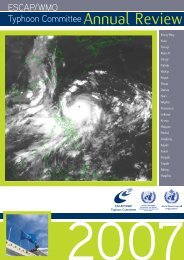TCAR - Typhoon Committee
TCAR - Typhoon Committee
TCAR - Typhoon Committee
You also want an ePaper? Increase the reach of your titles
YUMPU automatically turns print PDFs into web optimized ePapers that Google loves.
approximately 60 km horizontally and 60 layers up<br />
to 0.1 hPa) of JMA’s Global Spectral Model (GSM).<br />
In this upgrade, a new dynamical core and a number<br />
of calculation modifications were introduced into<br />
the low-resolution GSM. The core uses a reduced<br />
Gaussian grid and is being used in JMA operational<br />
high resolution GSM. The impact of the upgrade was<br />
investigated through forecast experiments from 20<br />
August to 9 October 2008. The ensemble mean track<br />
forecast error of tropical cyclones (TCs) in RSMC<br />
Tokyo’s area of responsibility was reduced as a result<br />
of the enhancement (Figure 23).<br />
The TEPS upgrade is expected to contribute to<br />
improving the accuracy of TC forecasts.<br />
Figure 23 Ensemble mean track forecast error (km)<br />
of TCs in RSMC Tokyo’s are of responsibility from<br />
20 August to 9 October 2008. The blue and red<br />
lines show the error of TEPS with the old dynamical<br />
core (a standard Gaussian grid) and that with the<br />
new dynamical core (a reduced Gaussian grid),<br />
respectively.<br />
The black dots denote the number of verification<br />
samples.<br />
(KRA1, 2, 4, 5, 7)<br />
a-5. Weekly report on extreme climate events<br />
JMA issues the weekly reports on extreme climate<br />
events around the world, including extremely heavy<br />
precipitation and/or weather-related disasters caused<br />
by tropical cyclones. These reports are distributed to<br />
NMHSs via the TCC website in near-real time (http://<br />
ds.data.jma.go.jp/gmd/tcc/tcc/products/climate/).<br />
<strong>TCAR</strong><br />
CHAPTER 1 - TYPHOON COMMITTEE ACTIVITIES<br />
Figure 24 Distribution of global extreme climate<br />
events (7 Oct 2009 - 13 Oct 2009); The figure<br />
indicates areas where extreme climate events were<br />
identified from SYNOP messages, and also shows<br />
the tracks of tropical cyclones based on preliminary<br />
data from Tropical Cyclone Centers worldwide.<br />
(KRA1, 2, 4, 5, 7)<br />
b. Hydrological Achievements/Results<br />
b-1. Approach of the International Flood Network<br />
(IFNet) and the Global Flood Alert System<br />
(GFAS)<br />
(1) IFNet and GFAS<br />
IFNet operates the Global Flood Alert System<br />
(GFAS) - a project offering the information needed<br />
to rank the risk of flood occurrence utilizing satellite<br />
observation of rainfall amounts. GFAS began<br />
automatic distribution of information in June 2006,<br />
and uses IFNet to suply rainfall information and flood<br />
occurrence probability (flood possibility) statistics<br />
based on global rainfall data observed every three<br />
hours by multiple earth observation satellites. This is<br />
considered to provide valuable information for flood<br />
forecasting and warnings in areas along large rivers,<br />
where it takes several days for data on rainfall in<br />
upstream areas to reach downstream regions where<br />
telemeter systems have not been developed, or in<br />
international rivers where it is difficult to transmit<br />
information on upstream areas to downstream<br />
regions. GFAS offers two types of services - one<br />
providing basic information and the other providing<br />
customized information.<br />
(2) The 5th IFNet General Meeting<br />
The 5th IFNet General Meeting was held on Thursday,<br />
19 March in Istanbul, Turkey, in<br />
conjunction with the 5th World Water Forum.<br />
Following a complimentary address by Mr. Hiroaki<br />
2009<br />
59

















